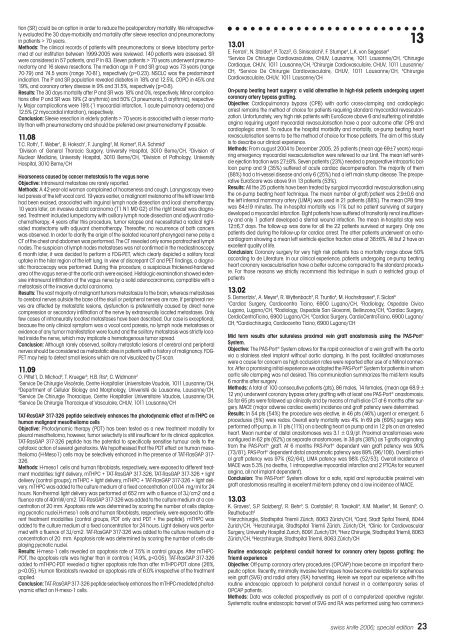Abstracts 4. Gemeinsamer Jahreskongress der ... - SWISS KNIFE
Abstracts 4. Gemeinsamer Jahreskongress der ... - SWISS KNIFE
Abstracts 4. Gemeinsamer Jahreskongress der ... - SWISS KNIFE
You also want an ePaper? Increase the reach of your titles
YUMPU automatically turns print PDFs into web optimized ePapers that Google loves.
swissknife spezial 06 12.06.2006 13:39 Uhr Seite 23<br />
tion (SR) could be an option in or<strong>der</strong> to reduce the postoperatory mortality. We retrospectively<br />
evaluated the 30 days-morbidity and mortality after sleeve resection and pneumonectomy<br />
in patients > 70 years.<br />
Methods: The clinical records of patients with pneumonectomy or sleeve lobectomy performed<br />
at our institution between 1999-2005 were reviewed. 140 patients were assessed. SR<br />
were consi<strong>der</strong>ed in 57 patients, and P in 83. Eleven patients > 70 years un<strong>der</strong>went pneumonectomy<br />
and 16 sleeve resections. The median age in P and SR group was 73 years (range<br />
70-79) and 7<strong>4.</strong>5 years (range 70-81), respectively (p=0.23). NSCLC was the predominant<br />
indication. The P and SR population revealed diabetes in 18% and 12.5%, COPD in 45% and<br />
19%, and coronary artery disease in 9% and 31.5%, respectively (p=0.8).<br />
Results: The 30 days mortality after P and SR was 18% and 0%, respectively. Minor complications<br />
after P and SR was 19% (2 arythmia) and 50% (3 pneumonia, 5 arythmia), respectively.<br />
Major complications were 19% (1 myocardial infarction, 1 acute pulmonary oedema) and<br />
12.5% (2 myocardial infarction), respectively.<br />
Conclusion: Sleeve resection in el<strong>der</strong>ly patients > 70 years is associated with a lesser mortality<br />
than with pneumonectomy and should be preferred over pneumonectomy if possible.<br />
11.08<br />
T.C. Roth 1 , T. Weber 1 , B. Hoksch 1 , F. Jungling 2 , M. Korner 3 , R.A. Schmid 1<br />
1 Division of General Thoracic Surgery, University Hospital, 3010 Berne/CH, 2 Division of<br />
Nuclear Medicine, University Hospital, 3010 Berne/CH, 3 Division of Pathology, University<br />
Hospital, 3010 Berne/CH<br />
Hoarseness caused by cancer metastasis to the vagus nerve<br />
Objective: Intraneural metastase are rarely reported.<br />
Methods: A 42-year-old woman complained of hoarseness and cough. Laryngoscopy revealed<br />
paresis of the left vocal cord. 19 years earlier, a malignant melanoma of the left lower limb<br />
had been excised, associated with inguinal lymph node dissection and local chemotherapy.<br />
10 years later, an invasive ductal carcinoma (T1 N1 M0 G2) of the right breast was diagnosed.<br />
Treatment included lumpectomy with axillary lymph node dissection and adjuvant radiochemotherapy.<br />
4 years after this procedure, tumor relapse and necessitated a radical rightsided<br />
mastectomy with adjuvant chemotherapy. Thereafter, no recurrence of both cancers<br />
was observed. In or<strong>der</strong> to clarify the origin of the isolated recurrent pharyngeal nerve palsy a<br />
CT of the chest and abdomen was performed. The CT revealed only some paratracheal lymph<br />
nodes. The suspicion of lymph nodes metastases was not confirmed in the mediastinoscopy.<br />
6 month later, it was decided to perform a FDG-PET, which clearly depicted a solitary focal<br />
uptake in the hilar region of the left lung. In view of discrepant CT and PET findings, a diagnostic<br />
thoracoscopy was performed. During this procedure, a suspicious thickened-hardened<br />
area of the vagus nerve at the aortic arch were excised. Histologic examination showed extensive<br />
intraneural infiltration of the vagus nerve by a solid adenocarcinoma, compatible with a<br />
metastasis of the invasive ductal carcinoma.<br />
Results: The vast majority of malignant tumors metastasize to the brain, whereas metastases<br />
to cerebral nerves outside the base of the skull or peripheral nerves are rare. If peripheral nerves<br />
are affected by metastatic lesions, dysfunction is preferentially caused by direct nerve<br />
compression or secondary infiltration of the nerve by extraneurally located metastases. Only<br />
few cases of intraneurally located metastases have been described. Our case is exceptional,<br />
because the only clinical symptom was a vocal cord paresis, no lymph node metastases or<br />
evidence of any tumor manifestation were found and the solitary metastasis was strictly located<br />
inside the nerve, which may implicate a hematogenous tumor spread.<br />
Conclusion: Although rarely observed, solitary metastatic lesions of cerebral and peripheral<br />
nerves should be consi<strong>der</strong>ed as metastatic sites in patients with a history of malignancy. FDG-<br />
PET may help to detect small lesions which are not visualized by CT-scan.<br />
11.09<br />
O. Pittet1, D. Michod 2 , T. Krueger 3 , H.B. Ris 4 , C. Widmann 2<br />
1 Service De Chirurgie Viscérale, Centre Hospitalier Universitaire Vaudois, 1011 Lausanne/CH,<br />
2 Department of Cellular Biology and Morphology, Univeristé de Lausanne, Lausanne/CH,<br />
3 Service De Chirurgie Thoracique, Centre Hospitalier Universitaire Vaudois, Lausanne/CH,<br />
4 Service De Chirurgie Thoracique et Vasculaire, CHUV, 1011 Lausanne/CH<br />
TAT-RasGAP 317-326 peptide selectively enhances the photodynamic effect of m-THPC on<br />
human malignant mesothelioma cells<br />
Objective: Photodynamic therapy (PDT) has been tested as a new treatment modality for<br />
pleural mesothelioma, however, tumor selectivity is still insufficient for its clinical application.<br />
TAT-RasGAP 317-326 peptide has the potential to specifically sensitise tumour cells to the<br />
cytotoxic action of several genotoxins. We hypothesised that the PDT effect on human mesothelioma<br />
(H-Meso1) cells may be selectively enhanced in the presence of TAT-RasGAP 317-<br />
326.<br />
Methods: H-meso1 cells and human fibroblasts, respectively, were exposed to different treatment<br />
modalities: light delivery, mTHPC + TAT-RasGAP 317-326, TAT-RasGAP 317-326 + light<br />
delivery (control groups); mTHPC + light delivery, mTHPC + TAT-RasGAP 317-326 + light delivery.<br />
mTHPC was added to the culture medium at a fixed concentration of 0.04 mg/ml for 24<br />
hours. Non-thermal light delivery was performed at 652 nm with a fluence of 3J/cm2 and a<br />
fluence rate of 40mW/cm2. TAT-RasGAP 317-326 was added to the culture medium at a concentration<br />
of 20 mm. Apoptosis rate was determined by scoring the number of cells displaying<br />
pycnotic nuclei.H-meso1 cells and human fibroblasts, respectively, were exposed to different<br />
treatment modalities (control groups, PDT only and PDT + the peptide). mTHPC was<br />
added to the culture medium at a fixed concentration for 24 hours. Light delivery was performed<br />
with a fluence of 3J/cm2. TAT-RasGAP 317-326 was added to the culture medium at a<br />
concentration of 20 mm. Apoptosis rate was determined by scoring the number of cells displaying<br />
pycnotic nuclei.<br />
Results: H-meso-1 cells revealed an apoptosis rate of 7.5% in control groups. After mTHPC-<br />
PDT, the apoptosis rate was higher than in controls (1<strong>4.</strong>9%, p
















